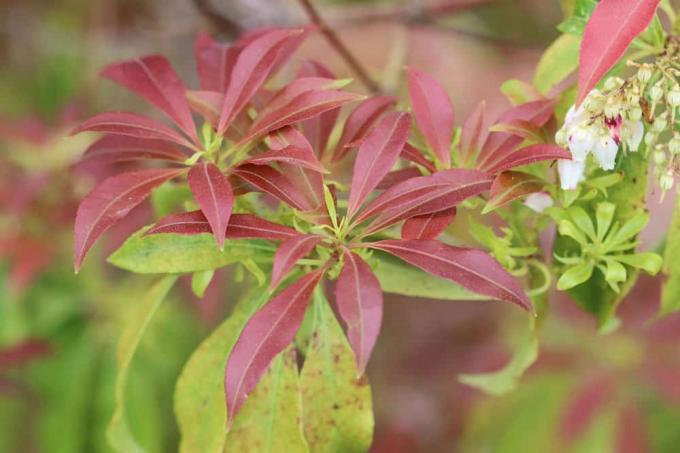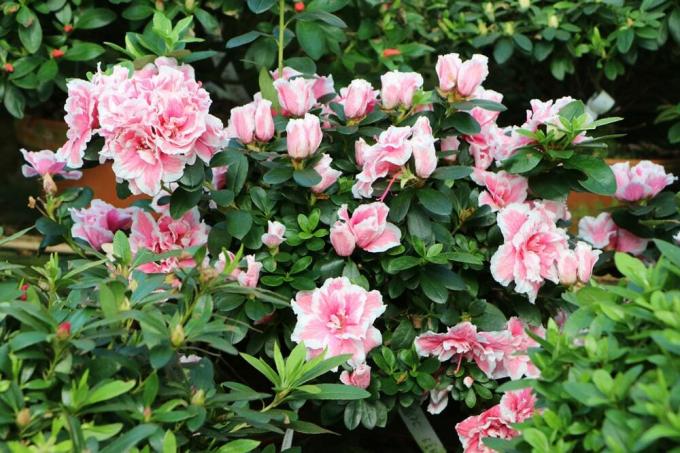

Table of contents
- Location
- substrate
- watering and fertilizing
- hibernate
- Cut
- diseases and pests
- frequently asked Questions
- Worth knowing about Photinia fraseri 'Red Robin' shortly
The photinia 'Red Robin' is one of the most beautiful evergreen trees and is characterized by the color change of the foliage. The intense red shoots of the young leaves are already impressive in spring. In May and June, the Photinia Fraseri sets the scene perfectly with its white flowers. After flowering, red berries adorn the ornamental shrub. With a size of up to three meters, the red medlar is not necessarily one of the small deciduous trees. The plant grows loosely upright and bushy wide.
Location
The colorful gem prefers a sunny location. Even in a semi-shady spot, she still feels comfortable. A shady location is less suitable. If the plant is in the shade, fewer flowers will form and therefore fewer fruits. In addition, the color of the leaves is diminishing. The glossy medlar does not tolerate strong winds at all. A sheltered spot is therefore recommended. Caution! The red fruits are poisonous. Therefore, the plant is not suitable for families with small children.
substrate
The evergreen darling makes no special demands on the soil. In principle, almost any garden soil is suitable. Whether acidic, neutral, calcareous or alkaline, the photinia gets along with almost any soil. A humus-rich, well-drained soil contributes to the well-being of the plant. However, the soil should not be rich in nutrients, not too wet and not too dry.
Tip:
Dense and heavy soil can be loosened with sand or gravel. This makes the soil permeable and overflowing water can drain away unhindered.
watering and fertilizing
Watering and fertilizing is also quite easy with the red medlar:
- The distinctive ornamental shrub thanks moderate watering with magnificent growth.
- After replanting, it should always be watered abundantly.
- Otherwise, only water when the top layer of soil has dried.
- This applies to potted plants as well as to colleagues that have been planted in the garden.
- If the Photinia Fraseri 'Red Robin' is cultivated as a tub or pot plant, excess water should be removed from the saucer or planter.
- The ornamental shrub does not like waterlogging at all.
- Commercially available fertilizer can be used for fertilizing.
- Apply long-term fertilizer (depot fertilizer) in spring
Tip:
To protect the plant from fungal diseases, the leaves should not be wetted when watering.
hibernate
As an evergreen ornamental shrub, the red medlar is hardy in regions with mild winters down to minus 20 degrees. However, in the case of long-lasting frosts, the deeper layers in the ground can also freeze. As a result, the wood can no longer absorb water, which means that it dries up
The most common reasons for damage to the plant are winter sun, rapid thawing and rapid freezing.
- If possible, winter sun should be avoided.
- Young Photinia Fraseri are not sufficiently hardy and need special protection.
- Freshly planted red medlars outdoors are just as sensitive to frost.
- Hardiness increases with age.
- Overwinter the plant in a shady, frost-free location.
- A sheltered spot on the house or garden wall is recommended.
Even in winter, watering is done on frost-free days when the top layer of soil is dry. Waterlogging should also be avoided in winter. If temperatures fall below -5 °C, potted plants need adequate winter protection. Without winter protection, the pot ball can freeze relatively easily.
To protect the plant, the bucket is first placed on feet so that excess water can drain off. To protect against icy temperatures, the bucket is loosely wrapped in fleece. Furthermore, the bubble wrap provides additional protection. If you fill dry leaves or straw between the fleece and the tub, you offer your darling the best possible winter protection.
If the medlar is used as a hedge, it is important to also protect the above-ground parts of the plant from the winter sun with fleece or fir branches. Otherwise, the root area is covered with foliage. If the temperatures rise above 0 °C again, the fleece is removed. This way the plant gets enough light and air again.
Cut

'Red Robin' grows quite quickly and yet only needs pruning once a year. The best time is at the end of June, after flowering. If necessary, either only a little thinned out or severely cut back. If the distinctive hedge plant is cut at the end of winter, new shoots will form, but hardly any buds will form in the coming year. With solitary plants, a pruning is not necessarily necessary. When pruning, not all flower panicles are removed, otherwise no new fruits will form. Because especially the fruits decorate the garden in the winter months. Basically, all shoots are only slightly shortened from the middle. In this way, enough light reaches the middle of the bush and the leaves sprout is promoted. The result is a shapely, dense hedge.
diseases and pests
aphids
Sometimes it can happen that aphids infest the red medlar. Shoots and young leaves are particularly affected here. Nettle broth helps with pest infestation. Heavy infestations are combated with preparations made from potash or rapeseed oil. As a preventive measure, the plant can be sprayed several times in the spring with a garlic infusion.
leaf tan
Leaf tanning is caused by fungi and is indicated by red and black spots on the leaf. The fungal disease is combated with a fungicidal preparation based on copper sulfate. Plant-strengthening agents such as horsetail extract help preventively.
vine weevil
It also happens that the vine weevil spreads on the leaves of the medlar. The root neck and roots can also be damaged by the larvae. To fight, collect the bugs. Irrigation water with nematodes eliminates larvae.
frequently asked Questions
Falling leaves are usually a sign that the distinctive ornamental plant is being kept too wet. Gloss medlar reacts sensitively to waterlogging. Therefore, it should only be watered when the top layer of the substrate is dry. Especially if the plant is cultivated in a bucket. Excess water in the coaster should be removed immediately.
In summer wind is not a big problem. However, prolonged drought and wind can damage the leaves. In the cold winter months, the photinia cannot tolerate strong winds. She dries up. Initially, the leaves are affected and over time the shoots dry back severely. Therefore, windy locations are not suitable.
Usually, the Photinia Fraseri is supplied with nutrients by fertilizer from spring. Because, like other plants, the photiniae prepares for the cold season in autumn. If fertilized at this time, this stimulates growth and the plant cells become soft. The consequences are frost damage.
Worth knowing about Photinia fraseri 'Red Robin' shortly
Care
- The photinia can be planted outdoors or in a tub as a single plant, but it is also often used as a hedge plant.
- It needs a place where it is sunny to partially shaded and where the soil has plenty of nutrients.
- She doesn't like too much wind, so a slightly sheltered spot is ideal.
- Its water requirements are moderate, so it doesn't need to be watered too often.
- To avoid waterlogging, which a medlar does not tolerate at all, very heavy and dense soil can be loosened up with gravel or sand.
- The Photinia fraseri is hardy, but young or newly planted plants should still be provided with a root protection in the first winter.
Danger:
However, this only affects the varieties that are evergreen. Some varieties of photinia drop their leaves in winter, they are insensitive to frost from the start.
merits
- The medlar flowers in May and June and then forms panicles with many small white flowers.
- In autumn, red fruits form, which are poisonous to humans but are readily eaten by birds.
- As long as they are not eaten by the birds, these fruits remain on the bush until winter.
- The Red Robin variety, which grows two to three meters high and is therefore often used as a privacy screen, is particularly popular.
Tip:
To make the hedge opaque, it is best to plant two to three plants per meter. However, this variety should only be planted in a sheltered spot and should also be given winter protection.
Cut
- A medlar grows up to three meters high and also quite wide, so that it may have to be cut back once.
- The best time for this is after flowering, around the end of June.
- Then the shrub can only be thinned out and shortened a little as required, but it can also be severely cut back.
- The plant tolerates pruning very well and grows up to 50 cm per year in a favorable location.
- However, because the leaves of the Photinia are quickly damaged with an electrical device, the cut should best be done by hand with hedge trimmers.
 garden editorial
garden editorial I write about everything that interests me in my garden.
Learn more about shrubs and woody plants

17 flowering hardy plants May to October
Many plants only show their full splendor for a short time. But there are also types and varieties with a particularly long flowering period from May to October, sometimes even longer. We present 17 flowering hardy plants.

25 hardy and evergreen ornamental trees
Ornamental trees are among the most popular plants in the garden. They have a decorative effect and set special accents in the green oasis. If you are tired of the gray of the cold season, you can plant trees that are hardy and evergreen.

Is barberry poisonous? | What is to be considered?
With their dense growth, numerous thorns and evergreen foliage, barberries are one of the most popular types of plants for a hedge in the garden. Before cultivating the sour thorn family (Berberidaceae), many ask themselves whether the plant is poisonous.

Azalea location: 6 important criteria
Azaleas are a flowering addition to the garden or living room, as long as they are in the right location. In the following guide to azaleas, we will tell you what to look out for.

How fast does a rhododendron grow? | Information about growth
How fast a rhododendron grows depends on various factors, including the variety, location and care. Growth can be accelerated under optimal conditions, while deficiencies lead to stunted growth.

Butterfly bush: the ideal location | Buddleia
The uncomplicated, easy-care and robust butterfly bush is suitable in the garden for borders, a flowering hedge or as a solitaire. Dwarf summer lilacs are ideal for pot culture. Buddleia bloom from June to October and are a magnet for many butterflies.

